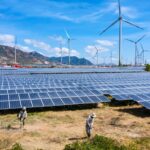Global adoption of renewable energy continues to surge in several countries, with many countries in Indonesia, Australia and Africa working to make more use of solar energy in recent months.
In early August, the Indonesian government announced an energy self-sufficiency plan to deploy 100 GW of solar energy Across the vast archipelago country, the solar storage mini grid has replaced diesel power plants to provide cheaper and cleaner power sources in 80,000 villages on more than 17,000 islands nationwide.
According to the management and operation of the Merah Putih Village Cooperative, everyone will have a 1 MW solar array (MWH) and the system will be managed and operated by the Merah Putih Village Cooperative. PV MAG. These small movements are expected to almost cut the village’s electricity cost by half.
See also: S Korea’s Lee to try to appease Trump with Big Shopbuilding Boost
This has been described as a “challenging” multi-year project – expected to be the largest rural electrification project in Southeast Asia – led by the Ministry of Energy and Mineral Resources and other national entities.
It will reportedly require training skilled solar installation workers through collaboration with universities and vocational schools in each province.
The announcement followed in June news that one of China’s top solar panel manufacturers, Rondi, plans to build a Large solar cell and module factories in West Java With Pertamina New & Reenwable Energy, a branch of the national utility Pertamina. The facility’s solar panel production capacity should almost double.
US solar manufacturer Seg Solar also reportedly hopes to build production in the country.
Home battery sales soar
Meanwhile, Australia is also expanding its solar deployment with a popular home battery discount offered by the federal government in July.
Australia has experienced a solar boom over the past decade and a half, as of the end of June 2025, 4.16 million photovoltaic devicethe total capacity exceeds 41.8 GW.
Now, solar now provides one-fifth of the country’s power, and the ratio is expected to increase further in the coming years.
“As the government’s cheaper home battery program began in early July, Australian homes have installed 15 MW of batteries per day, or five times the average daily increase in 2024,” he said. Sydney Morning Pioneer Said on August 22.
Under the plan, home battery systems have been reduced by nearly a third, and homeowners who have installed panels on their roofs have seized the opportunity to use more electricity and sell over-the-top operators at higher prices at peak prices.
“The surge in new clean energy will support additional solar energy, which will reduce Australia’s overall greenhouse gas emissions by 3.4% by 2035, equivalent to about 21 million tons of carbon dioxide – helping the government achieve its new emission reduction target in the coming weeks,” it said.
Analysts say the surge in adoption of household batteries shows that solar and battery sectors can rapidly expand operations, suggesting that homes can play a greater role in the wider energy transition.
It said that the adoption of household battery batteries is now down 10% from the power sector compared to the country’s 2005 levels.

Africans buy more Chinese solar energy
Meanwhile, a new Wired report says countries across Africa have imported more solar panels from China this year. Some analysts believe this could be the beginning of a huge move that facilitates the transition from fossil fuels to renewable energy sources.
Dave Jones, chief analyst at global energy think tank Ember, tracks the value of Chinese solar panels through customs data, said the rise in purchases came from nearly twenty small African countries, most of them bought last year.
In May, African countries purchased a record 1.57 GW solar module from a Chinese group manufacturer, he said.
Chad is an underdeveloped country that imports enough solar panels to replace its country’s current power generation capacity. Jones told wired.
Earlier this year – March – Carbon Summary Report says Saudi Arabia and Pakistan It is one of the top importers of solar panels in China in 2024. This data is also from Ember.
“According to Ember Export Explorer, China’s solar panel exports to the south of the world have doubled in the past two years, surpassing global sales for the first time since 2018,” it said.








